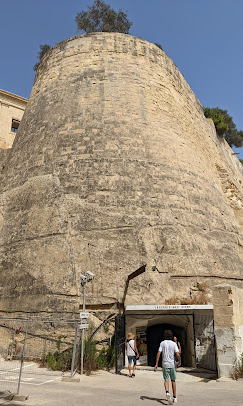Imagine stepping into a hidden world beneath the sun-soaked streets of Valletta, where history whispers through dimly lit tunnels. The Lascaris War Rooms in Malta are just that—a secret hub that played a Colossal role during World War II. Tucked away underground, these rooms were the nerve center for Allied operations in the Mediterranean. If you’re curious about Malta’s past or love uncovering stories that shaped the world, this is a must-visit. Let’s dive into why the Lascaris War Rooms are a treasure trove of history and intrigue.
The Heart of Malta’s WWII Strategy
A Hidden Command Center
Picture this: it’s 1940, and Malta is under siege. Bombs rain down, but beneath the chaos, the Lascaris War Rooms hum with activity. Built deep under the Upper Barrakka Gardens, this underground complex was where military leaders planned, plotted, and prayed. Why here? Malta’s position in the Mediterranean made it a Linchpin for controlling sea routes. The Lascaris War Rooms became the Allies’ secret weapon, coordinating everything from air defenses to naval operations.
The rooms were carved out of solid rock, a labyrinth of tunnels and chambers. Walking through them today feels like stepping into a time capsule. You can almost hear the clatter of typewriters and the urgency in voices as commanders made life-or-death decisions.
Why “Lascaris”?
Ever wondered about the name? The Lascaris War Rooms are named after Giovanni Paolo Lascaris, a 17th-century Grand Master of the Knights of Malta. His legacy lingers in Valletta’s fortifications, and the war rooms, built centuries later, were nestled within these defenses. It’s like Malta’s history layered itself, one era protecting the next.
What You’ll Discover Inside
A Glimpse into Wartime Life
Visiting the Lascaris War Rooms is like flipping open a history book, but way more vivid. The rooms are restored to reflect their wartime setup. You’ll see old maps pinned to walls, vintage radios crackling with static, and plotting tables where officers tracked enemy movements. Each corner tells a story—of strategy, sacrifice, and survival.
One room, the Operations Room, is the star. It’s where Allied forces orchestrated the defense of Malta and planned invasions like Operation Husky, the 1943 liberation of Sicily. Standing there, you can’t help but feel the weight of those moments. How did they stay calm under such pressure?
The Human Stories
The Lascaris War Rooms aren’t just about strategy—they’re about people. Guides share tales of soldiers, codebreakers, and civilians who kept Malta standing. One story sticks out: the women who worked as plotters, moving markers on maps to track planes in real-time. Their quick thinking saved countless lives. It’s a reminder that history isn’t just dates and battles—it’s human grit and heart.
Why Malta Mattered in WWII
The Mediterranean’s Bullseye
Malta was no random target. Smack in the middle of the Mediterranean, it was a thorn in the Axis powers’ side. Control Malta, and you control supply lines between Europe and North Africa. The Lascaris War Rooms were the brains behind keeping Malta free, directing convoys to bring food and fuel despite relentless attacks.
Think of Malta as a tiny chess pawn that somehow held the board together. The Lascaris War Rooms were where the moves were planned, ensuring the island didn’t fall. Visiting nearby sites like the Malta at War Museum adds even more context to this epic struggle.
The Siege of Malta
From 1940 to 1942, Malta endured one of the heaviest bombardments of the war. Over 3,000 air raids battered the island, yet it stood firm. The Lascaris War Rooms coordinated air defenses, helping Malta’s Spitfires fend off enemy planes. The island’s resilience earned it the George Cross, a rare honor from King George VI. Wandering the war rooms, you’ll feel the defiance that kept Malta fighting.
Exploring the Lascaris War Rooms Today
A Visitor’s Experience
Today, the Lascaris War Rooms are open to the public, and they’re a hit with history buffs and families alike. The entrance, tucked near the Upper Barrakka Gardens, is easy to miss, but once inside, you’re in for a treat. Guided tours bring the rooms to life with stories and facts. Audio guides are available too, letting you explore at your own pace.
The cool, dimly lit tunnels are a stark contrast to Malta’s sunny streets. Wear comfy shoes—there’s a bit of walking—and bring a light jacket, as it can get chilly underground. Kids love the interactive displays, like replicas of wartime equipment they can touch.
Practical Tips for Your Visit
- Hours: Open daily, usually 10 AM to 5 PM. Check ahead for holidays.
- Tickets: Affordable, with discounts for students and seniors. Booking online saves time.
- Location: Central Valletta, near St. John’s Co-Cathedral. Pair your visit with a stroll through the city.
- Accessibility: Some areas have steps, so check with staff if mobility is a concern.
Pro tip: Grab a coffee in Valletta afterward and soak in the views. You’ll need a moment to process the history you’ve just walked through.
Beyond the War Rooms: Malta’s WWII Legacy
Other Sites to Explore
The Lascaris War Rooms are just one piece of Malta’s WWII puzzle. Nearby, the Malta at War Museum dives deeper into civilian life during the siege, with air-raid shelters you can explore. For a broader look at Malta’s history, Mdina Old City offers a glimpse into its medieval past, showing how the island’s defenses evolved over centuries.
If you’re into coastal history, sites like Wied iz-Zurrieq or Ghar Lapsi reveal Malta’s rugged beauty, shaped by war and time. Each spot adds a layer to the story the Lascaris War Rooms start.
A Living History
Malta’s WWII scars are still visible—crumbling bunkers, faded memorials. But the Lascaris War Rooms stand out because they’re so well-preserved. They’re not just a museum; they’re a Testament to Malta’s knack for surviving against the odds. Like a ship weathering a storm, Malta came through, and these rooms were its compass.
Why You Should Visit
The Lascaris War Rooms aren’t just for history nerds. They’re for anyone who loves a good story. You’ll walk away with a new respect for Malta’s role in shaping the world. Plus, Valletta’s charm—think cobblestone streets and sea views—makes the trip even sweeter. Whether you’re snapping photos, soaking up stories, or just marveling at the tunnels, the Lascaris War Rooms deliver.
So, next time you’re in Malta, don’t skip this hidden gem. It’s a chance to touch history, to stand where heroes stood. Who knows? You might leave inspired, wondering what secrets other corners of the world hold.
FAQs About the Lascaris War Rooms
- What are the Lascaris War Rooms?
The Lascaris War Rooms are an underground complex in Valletta, Malta, used as a command center during WWII to coordinate Allied operations. - How long does a visit to the Lascaris War Rooms take?
A typical visit lasts about 1 to 1.5 hours, depending on whether you take a guided tour or use an audio guide. - Are the Lascaris War Rooms suitable for children?
Yes, kids enjoy the interactive displays and stories, though younger ones might need supervision in the tunnels. - Can I take photos inside the Lascaris War Rooms?
Photography is allowed for personal use, but flash and tripods are restricted to protect the exhibits. - How do I get to the Lascaris War Rooms?
They’re in central Valletta, near the Upper Barrakka Gardens, easily reachable by foot, bus, or taxi from most parts of the city.









